Humor's Influence on Textile Art: The World of Funny Tapestry
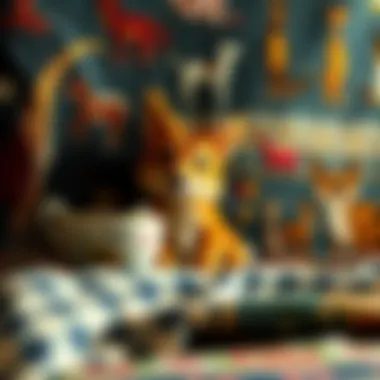
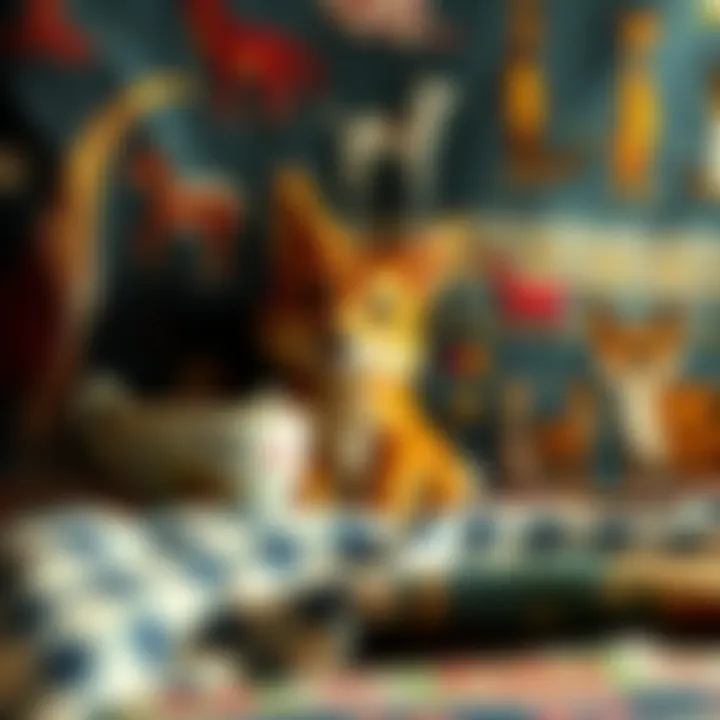
Intro
In the intricate world of textile art, humor often treads a fine line, blending creativity with amusement. While one might typically think of tapestry as a medium for serious themes and historical narratives, an emerging trend showcases its potential for wit and humor. This exploration is not merely an academic exercise; it reflects a shifting landscape in how we perceive art, culture, and self-expression through textiles.
The infusion of funny motifs into tapestry encourages artists and audiences alike to rethink what these pieces represent. No longer confined by notions of elegance and grandeur, tapestry art evolves to embrace irony, satire, and levity. The ensuing dialogue surrounding these innovations reflects broader societal currents, wherein humor serves not just as entertainment, but also as a commentary on norms and traditions.
As we embark on this journey through the whimsical tapestry of humor, we'll delve into how contemporary creators are using comedic elements to challenge the status quo while connecting with a diverse array of viewers.
Latest Fashion Trends
Seasonal Style Highlights
Tapestries that flirt with humor often find their way into seasonal fashion trends, influencing collections in surprising ways. Designers are adopting playful patterns and quirky images, making their pieces not only garments but also conversation starters. For instance, an oversized jacket featuring a cartoonish depiction of a common farming scene might spark intrigue and laughter on the runway. In this way, humor infiltrates everyday wear, transforming the mundane into the marvelous.
Some prominent trends include:
- Visual Puns: Graphic tees or bags with witty text or imagery that challenges the viewer's perception.
- Whimsical Embroidery: Tapestries adorned with laughter-inducing designs, often blending textures and colors that evoke lightheartedness.
- Playful Accessories: From bags shaped like food items to shoes featuring fictional characters, playful accessories find their place alongside more traditional pieces.
Influential Runway Looks
Fashion shows are the breeding ground for imaginative designs, and the entry of humor into textile appears prominently.
Consider a recent collection that paired humorous tapestry with sleek silhouettes, juxtaposing laughter with elegance. Here, garments not only showcased artistry but also a sense of fun that resonated with audiences. This blending helps in setting a tone where fashion becomes an avenue for self-expression, allowing one to showcase personality through humor.
The infused humor does not stop at textiles; it extends to the entire presentation, where designers employ unexpected elements to create memorable runway experiences. This return to the whimsical invites a broader demographic to explore fashion without the fear of judgment, emphasizing the importance of individuality and self-acceptance.
"Humor in fashion isn't just a joke; it's an invitation to take ourselves less seriously while still making bold statements."
Sustainable Fashion Practices
Ethical Sourcing of Materials
In the realm of humor-infused textiles, sustainability is not forgotten. Artists and designers prioritize ethical sourcing, ensuring that their humorous tapestries make a statement not just visually but also morally. This encompasses:
- Natural Fibers: Using organic cotton, linen, or hemp, which are less harmful to the environment.
- Recycled Materials: Innovative use of discarded textiles, breathing new life into fabric that might have otherwise gone to waste.
Eco-Friendly Clothing Care
To ensure the longevity of humorous textiles, eco-friendly care methods are crucial. These practices may include:
- Gentle Washing Techniques: Using cold water and mild detergents helps preserve color and integrity of intricate designs.
- Air Drying: Reduces energy usage and minimizes fabric wear caused by high heat.
Foreword to Tapestry Art
When venturing into the world of textile art, one cannot overlook the profound significance of tapestry. Tapestry is not merely fabric stitched with threads; it represents a unique intersection of craftsmanship, storytelling, and cultural expression. In this article, we delve into how humor weaves its way into the fabric of tapestry art, emphasizing not only how it broadens artistic boundaries but also how it can captivate and resonate with diverse audiences.
Defining Tapestry
Tapestry is often best described as a form of textile art that employs a loom to create a visual narrative through intertwined threads. This artistry allows for intricate designs and motifs to materialize, often drawing on rich historical traditions. One defining feature of tapestry is its ability to produce detailed imagery, where both the warp and weft threads contribute to the final piece. The world of tapestry is not confined to any single meaning; it can represent anything from elaborate landscapes to intimate familial scenes, and importantly, can convey humor as a vital element in expression and engagement.
Historical Evolution of Tapestry
Ancient Origins
The beginnings of tapestry can be traced back to ancient civilizations. In these formative years, tapestries were more than decorative; they served practical purposes such as insulation and room division. The ancient Egyptians, for example, used tapestry-like methods to craft wall coverings that added both beauty and functionality to their homes. An interesting characteristic of ancient tapestries is their narrative quality, which often depicted mythological tales or significant events. This aspect makes them a valuable topic for our exploration, as it illustrates that humor, too, can be grounded in historical storytelling. The inclusion of comedic elements, even if unintentional, sheds light on societal norms and collective consciousness of those eras, making it a treasure trove for modern artists looking to connect laughs with history.
Renaissance Influence
The Renaissance period marked a transformative phase for tapestry art, where it began embracing more intricate storytelling and detailed portrayals of human emotions. Artists like Jean Lurçat introduced a surge of personality and even humor into their works. What’s significant about the Renaissance influence is its fusion of artistic styles with humor. This era’s tapestries often contained allegorical humor, weaving satire about the social and political climates of the time. Shifts towards using brighter colors and bolder patterns also enhanced the humorous aspects, making these tapestries not only visually appealing but also conversations starters. Thus, they became essential in our article for illustrating how humor in tapestry has always had deep roots in cultural commentary.
Modern Revival
In the contemporary landscape, there's been a marked revival in tapestry art, particularly in its capacity to examine and employ humor. Artists today are experimenting with innovative materials and techniques, crafting works that reflect modern sensibilities, life’s absurdities, and the universal quest for joy. The modern revival of tapestry offers a fresh lens through which to view humor in textiles, showcasing everything from whimsical narratives to poignant social observations. This aspect makes modern tapestries a central focus for our analysis, as they highlight how humor has evolved and adapted to reflect current societal themes, resonating with viewers on multiple levels. Their playful interpretations challenge preconceived notions about what tapestry can be and, in effect, bridge the gap between traditional craftsmanship and contemporary expression.
Through these explorations of tapestry's origin, Renaissance transformation, and modern interpretations, the reader gains a multifaceted understanding of how humor finds its way into this textile art form. The interplay of these historical elements shapes a comprehensive dialogue on the relevance of humor in tapestry, setting the stage for further examination in the subsequent sections of this article.
"Art is not what you see, but what you make others see."
- Edgar Degas
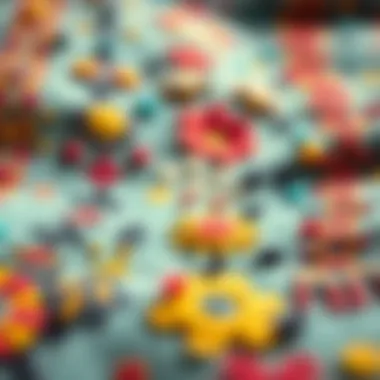
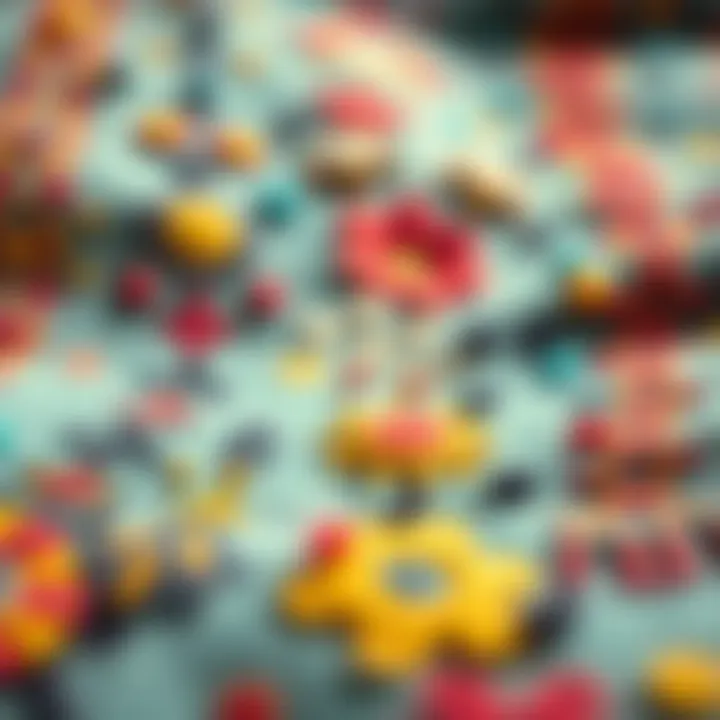
Links for further reading:
The Concept of Humor in Art
Understanding humor's role in art, particularly in tapestry, opens up a wealth of perspectives and interpretations. Humor is not merely a light-hearted addition; it is a potent tool that artists leverage to convey deeper meanings and critique societal norms. This section explores the essence of humor in artistic contexts, highlighting its relevance in today's tapestry landscape.
Understanding Artistic Humor
Importance in Artistic Expression
Artistic humor serves as a unique lens through which audiences can engage with and interpret complex themes. It is not just about evoking laughter; it's about providing commentary in a manner that is accessible and compelling. In the realm of tapestry, this can manifest through motifs that challenge conventional perceptions, turning serious topics into more digestible reflections. The playful nature of humor can also bridge gaps between the artist and the audience, creating an inviting space for dialogue.
Consider, for example, modern tapestries that incorporate puns or visual jokes. Such pieces spark curiosity and encourage viewers to explore multiple layers of meaning. Rather than simply absorbing information, the audience is prompted to think critically about the subject matter. This characteristic makes humor a compelling choice in tapestry, as it invites engagement and reflection.
Psychological Impact on the Audience
Humor in art also has profound psychological effects. Engaging with humorous pieces can invoke positive emotions, which often enhances the overall experience. The act of laughing not only lightens the mood but can also facilitate connections among viewers. Furthermore, in a format like tapestry, which often tells a story or conveys a message, humor can serve to diffuse tension surrounding heavy subjects, making them more approachable.
One unique feature of psychological humor is its relatability. Tapestries that reflect shared experiences or cultural quirks can resonate deeply within communities, facilitating a sense of belonging and cultural identity. This advantage ties the audience closer to the art and enhances their appreciation, allowing them to see reflections of their own lives in the narratives depicted.
Cultural Perspectives on Humor
Humor Across Different Cultures
Humor in tapestry is not a monolith; it varies widely across cultures. Each society brings its unique flavor to the humorous motifs present in their textile art. By examining the variations of humor across cultures, we discover how humor reflects societal values and historical contexts. For instance, in some cultures, irony might take center stage, while in others, slapstick humor might reign supreme.
This aspect of cultural humor in art enriches the tapestry by infusing it with layers of meaning. By exploring these differences, artists can highlight cultural disparities, allowing audiences to appreciate the richness of diversity. The unique features of cultural perspectives on humor also add depth to the narrative of a piece, enhancing its overall visual language.
Societal Trends and Humor
The humor we see in tapestry can also serve as a mirror to societal trends. An artist's decision to inject humor into their work often correlates with the collective sentiment of the time. If society is grappling with issues, humorous tapestries might offer a means of coping or a platform for critique. Conversely, in times of prosperity, humor might take on a more whimsical tone, reflecting lighter, celebratory themes.
Humor’s evolving role amid these societal trends illustrates its dynamism and relevance. By incorporating current events or popular culture into their work, artists create a dialogue that transcends generations. This unique feature of contemporary humor in tapestry often invites discussion and critique, making it not only a source of enjoyment but also a catalyst for conversation about larger themes in society.
"Art is an expression of one’s feelings; humor is the bridge that connects those feelings to others."
Humor, found in tapestry art, thus serves multiple purposes—creating communion, offering commentary, and reflecting broader societal influences—all while encouraging the viewer to engage more critically with both the piece and the larger world.
Developing the Aesthetic of Funny Tapestries
In the realm of tapestry art, the infusion of humor transforms traditional textile craft into a vivid canvas of expression. By focusing on the aesthetic development of funny tapestries, this segment explores how humor not only embellishes but elevates the artistic narrative. Funny tapestries create a dialogue with viewers, often challenging societal norms, and offering alternate perspectives through playful motifs.
Themes Commonly Explored
Social Commentary
Social commentary within funny tapestries serves as a powerful lens through which artists convey critiques of contemporary society. This facet of humor in art allows individuals to address serious issues—political satire, social injustice, or environmental concerns—often wrapped in a comical manner. Such an approach engages audiences by disarming their defenses, creating a space where humor invites reflection on critical topics. The key characteristic of social commentary is its double-edged sword: while it can offer poignant insights, it also risks alienating those who may not appreciate humor’s ability to deal with sensitive issues. The successful integration of humor often hinges on the artist's ability to balance levity with the gravity of the subject matter.
Personal Anecdotes
The exploration of personal anecdotes in tapestries carries a unique charm, as it allows artists to infuse their narratives with humor derived from lived experiences. Personalized humor makes artwork relatable and accessible, fostering a connection between the artist and the viewer. The key characteristic here is the sincerity that comes with sharing one's story, which often resonates with audiences on a deeper level. Personal anecdotes can be whimsical, incorporating everyday mishaps or absurdities that elicit laughter. However, these tales may sometimes fail to engage broader audiences if the humor feels too insular or specific.
Whimsical Imagery
Whimsical imagery is characterized by its playful, often surreal elements that invite curiosity and joy. This style stands out for its distinctive ability to distort reality, presenting common scenes with a twist that sparks laughter. In funny tapestries, whimsical imagery captivates the eye, encouraging viewers to engage with the art beyond surface aesthetics. The unique feature of whimsy lies in its flexibility; it can evoke nostalgia, provoke thought, or simply entertain. However, it can also skirt the line of absurdity, potentially alienating viewers who prefer a more conventional narrative thread in art.
Techniques and Materials
Yarn Selection
Yarn selection is pivotal in the crafting of funny tapestries, as the texture and color of yarn significantly influence the overall aesthetic. Bright and varied hues can enhance humor by creating an inviting atmosphere, drawing on the emotional responses colors evoke. The key characteristic of yarn selection lies in the mix of materials—wool, cotton, or synthetic fibers—that not only contributes to the visual aspect but also dictates the tactile experience. The advantage of choosing varied textures is that it adds depth, making the piece more dynamic. Yet, the challenge often lies in balancing quality with the vibrancy needed for humorous effects.
Weaving Techniques
Different weaving techniques can drastically alter the visual outcome of a humorous tapestry. Advanced methods, such as Jacquard weaving or tufting, allow for intricate designs that encapsulate humor better than simpler methods could. The introduction of layering and textural contrast through techniques creates a rich, engaging experience for viewers. This complexity can be beneficial, as it attracts attention and offers multiple points of engagement. However, such techniques could potentially detract from the humor itself if they overshadow the intended message.
Color Theory
Color theory plays a crucial role in the humor of tapestry art. Understanding how colors interact enables artists to enhance their comedic narratives effectively. Certain colors can elevate emotions and generate specific responses; for instance, vibrant reds and yellows can evoke feelings of joy, making the humor more palpable. The key characteristic of color theory is its psychological impact on viewers, as colors can significantly influence perception. The advantage of employing a thoughtful color palette is the ability to amplify comedic elements; however, a poorly chosen scheme might result in confusion or misinterpretation of the intended humor.
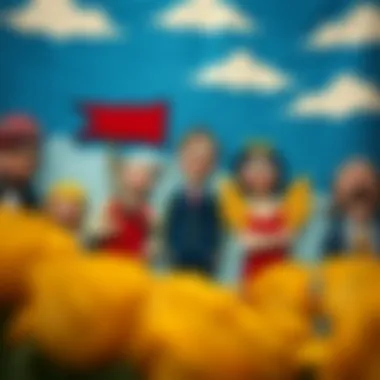
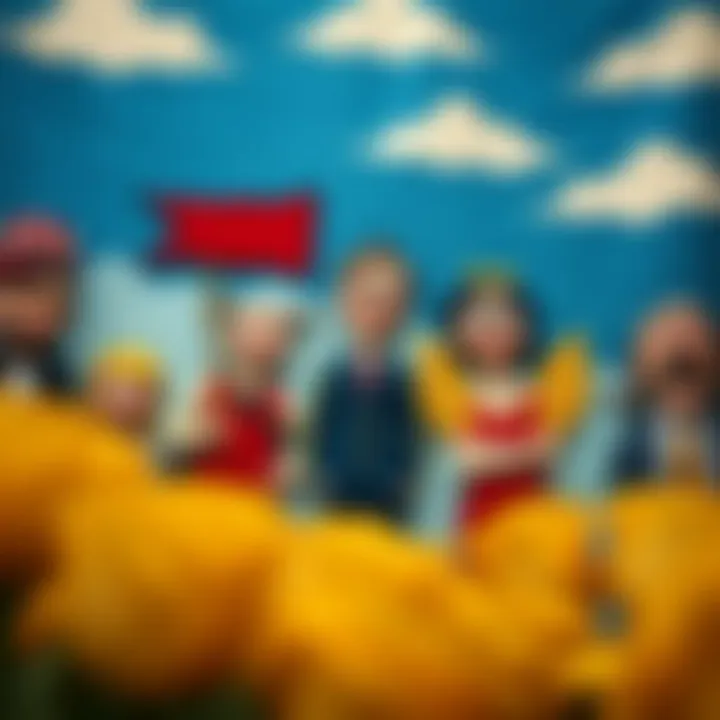
The aesthetic of funny tapestries invites all who encounter them to rethink their perspectives, balancing humor with craftsmanship in a way that sparks joy and conversation.
Notable Artists and Their Works
The exploration of humor in tapestry art would be remiss without delving into the contributions of notable artists in this field. Their works not only bring a unique flavor to their pieces but also demonstrate how laughter and artistry intertwine in an impactful manner. The significance of recognizing these artists lies in their ability to capture cultural moments and transform them into narratives that resonate with diverse audiences.
Contemporary Tapestry Artists
Artist Profiles
When examining contemporary tapestry artists, one sees a vibrant blend of traditional skills and modern thought. Artists like Maggie The Cat embrace humor through quirky designs and satirical takes on everyday life. The profiles of these artists offer insights into their inspirations and approaches, making them centerpiece figures in the realm of funny tapestries.
A key characteristic that sets these artists apart is their capacity to engage audiences not just visually but emotionally. This connection draws the viewer into a dialogue with the piece, elevating the tapestry from mere decoration to conversation starter. For instance, artist Eliza Fisher, known for her humorous critique of food culture, weaves threads that prompt laughter while also encouraging reflection on societal norms regarding consumption.
While the appeal of these artist profiles often lies in their accessible humor, it can sometimes overshadow deeper artistic messages. These artists walk a delicate line between comedy and seriousness, ensuring their works remain layered and meaningful.
Signature Styles
The signature styles adopted by contemporary tapestry artists represent a diverse spectrum of humor that adapts to various narratives. One could argue that artists such as Barbara Knutson have developed recognizable motifs that evoke chuckles derived from the absurdities of modern life. Her tapestries often incorporate witty phrases alongside vivid imagery, presenting an inviting landscape for viewers to explore.
The unique feature of these signature styles is their propensity for innovation. They provide artists the chance to blend techniques and mediums, creating pieces that are not only funny but also visually captivating. However, this exploration of unorthodox styles may alienate traditionalists who find comfort in more classic designs. Consequently, some humor may get lost in translation, depending on the audience’s familiarity with contemporary art movements.
Historic Influences on Humor
Famous Historical Tapestries
Looking back at history, famous tapestries like The Apocalypse Tapestry—found in Angers, France—highlight an earlier use of humor through rich narrative scenes that range from the profound to the absurd. These historical artifacts have laid a foundation for modern artists to draw upon, proving that humor has always held a place in tapestry art. The subtle comedic elements embedded within serious themes offer a multi-dimensional experience that enhances viewer engagement.
The characteristic of humor in historical tapestries often embodies a critique of social norms, giving each piece layers of meaning. Their inclusion in this article serves as an anchor, reminding contemporary artists of the cultural weight humor can carry.
Influential Art Movements
Influential art movements, specifically the Dada and Surrealist movements, have left indelible marks on how humor is perceived within tapestry art. The Dadaists challenged artistic conventions with their absurdist humor, a sentiment that echoes in today’s tapestry creations. Their legacy showcases how humor can disrupt norms and provoke thought, aligning with the goals of modern tapestry artists who wish to push boundaries.
The significant aspect of these movements is the way they dismantled preconceived notions of what art could be. By subtly stitching together the unexpected, contemporary artists adopt techniques that tap into this rich tradition of satire and irreverence. However, there's a risk that such influences may lead to confusion or misinterpretation if viewers aren’t well-versed in art history, posing a challenge in balancing humor with conceptual depth.
Humor in tapestry is not merely embellishment; it’s a challenge to perceptions, inviting viewers to laugh while they reflect.
End
Overall, the artists and movements discussed illustrate the profound impact of humor within tapestry. This vibrant field demonstrates that art is much more than aesthetic pleasure; it is a rich and dynamic medium that speaks to societal themes, personal stories, and shared laughter. The journey through artists’ profiles and historical contributions enriches our understanding of tapestry art as a continually evolving form of expressive communication.
The Intersection of Tapestry and Fashion
Understanding the intersection of tapestry and fashion adds layers of richness to the overall study of textile art, particularly when humor weaves its way through the fibers. Textile art has long functioned not just as a means of storytelling but also as an expressive form that can inform and shape personal style. The inclusion of humorous elements in fashion textiles broadens this conversation significantly, allowing for a dialogue between tradition and contemporary trends.
Humorous Textiles in Fashion
Current Trends
When looking at current trends, it’s clear that humor in textiles has struck a chord with consumers and designers alike. Humor can be a liberating twist in an often-serious industry. It encourages playful interactions with fashion, making it feel approachable. The key characteristic of these trends is their ability to engage audiences visually and emotionally, blending absurdity with craftsmanship. As a beneficial choice, humorous motifs enrich collections, often being used in streetwear or casual fashion lines, effectively captivating a younger audience eager for authenticity.
Distinctive features of current trends include bold graphics and tongue-in-cheek phrases seamlessly integrated into designs. While this appeals to a wide audience, one must consider that oversaturation of humor might lead to aesthetic fatigue, where novelty wears off faster than desired, leaving unique pieces overshadowed.
Designer Collaborations
Designer collaborations stand as a testament to the evolving fabric of fashion industry dynamics, emphasizing humor as a focal point. Many renowned designers have partnered with textile artists to create pieces that not only function as apparel but also provoke thought and laughter. The key attraction here is the blending of styles and perspectives; the unique takes on humor can elevate a piece's significance, allowing it to shift between being fashion and art.
Collaborations often push the boundaries, presenting consumers with textiles that offer witty commentary on societal issues or simply playfulness. However, this approach can come with drawbacks. For example, a significant emphasis on humor can sometimes misconstrue a brand’s original identity, creating confusion among long-time customers who appreciate a more classic aesthetic.
Personal Style Influences
Incorporating Humor into Personal Wardrobes
Incorporating humor into personal wardrobes serves as an intriguing reflection of one's personality and outlook on life. This facet of fashion allows individuals to express their authenticity through whimsical items without the heavy burden of societal expectations. The defining characteristic here is freedom—wearers are encouraged to show their quirky side through patterned socks, playful tee shirts, or patterned trousers. This approach appeals significantly to those looking to stand out in a crowded fashion market.
Adding humorous textiles can act as conversation starters, often revealing shared experiences or interests in a light-hearted way. Nevertheless, one should consider the potential for misinterpretation of humor; it’s subjective, after all. What resonates with one may not evoke the same response from another, which can sometimes lead to awkward situations.
Consumer Reactions to Humorous Textiles
Consumer reactions to humorous textiles provide deep insights into cultural currents and shifts in attitudes towards fashion. As these pieces often provoke laughter and lightheartedness, they have been met with enthusiasm from audiences keen on breaking the monotony of traditional designs. One might say the key characteristic of this reception is its celebration of individuality—humorous textiles make wearers feel unique and connected, lifting spirits with each wear.
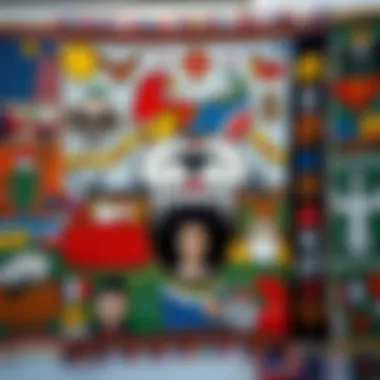

The unique feature of consumer reactions is their ability to create an emotional bond with the garments. However, humor can be a double-edged sword; some consumers might perceive a lack of seriousness or sophistication, which can polarize opinions. Balancing humor with aesthetics will determine whether a piece becomes a staple or a fleeting novelty in one’s wardrobe.
Humor in textile art transcends boundaries, enhancing personal expression in both subtle and bold ways.
As we can see, the intersection of tapestry and fashion, infused with humor, affects how we perceive, interact with, and ultimately appreciate textiles in everyday life.
Cultural Impact of Funny Tapestry
Understanding the cultural impact of funny tapestry dives into how humor can intertwine with textiles, creating conversations that ripple through various societal layers. Funny tapestries speak volumes, encapsulating humor that reflects, critiques, or celebrates human experiences. Through wit and light-heartedness, they challenge the traditional notions of tapestry, opening itself to various interpretations and broader appeal.
Public Perception
Market Trends
Market trends concerning funny tapestry have shown a remarkable rise in demand among diverse demographics. This appeal often stems from the increasing integration of humor in everyday objects. It transforms walls into lively spaces and instigates laughter and interaction.
One key characteristic of current market trends is the adaptability to consumer preferences. People are seeking unique pieces that resonate personally, moving away from conventional art. Funny tapestries not only add color but also character to environments, making them a desirable choice for many.
A unique feature of this trend is how it appeals to younger audiences. They often favor quirky, relatable designs that can spark conversation. However, a disadvantage may arise from the risk of humor becoming oversaturated and losing its fresh appeal.
Art Exhibitions
Art exhibitions featuring funny tapestries serve as a critical bridge connecting artists and audiences. These events provide a platform for showcasing innovative works that reflect modern sensibilities. They foster a communal appreciation for art, not only as an aesthetic but as a medium of expression.
The key characteristic of such exhibitions is their interactive nature. Viewers might engage with the art, adding their interpretations and reactions. Visitors often walk away with a deeper understanding of how humor operates within art.
Art exhibitions can uniquely highlight local talent and celebrate cultural narratives. This incorporation of funny designs helps to encourage a less serious atmosphere. Nonetheless, the challenge lies in balancing the light-heartedness of humor with serious themes, to ensure the message isn’t lost.
Critiques and Controversies
Artistic Integrity
The dialogue around artistic integrity in funny tapestry often highlights the balance between traditional craftsmanship and contemporary humor. Artists might push against the boundaries of what is generally accepted as 'art,' causing tension in the industry. The main concern is whether humor can coexist with the high standards of textile craftsmanship.
A significant aspect of this discourse is the consideration of innovative techniques such as irony or satire, which can be seen as beneficial for most contemporary artists. They allow for personal expression and relatability in a field sometimes deemed aloof.
However, a downside arises when humor overshadows the craftsmanship itself. Critics may argue that focusing too much on punchlines compromises the skill involved in tapestry-making, potentially undermining the art form’s integrity.
Humor vs. Taste
The intersection of humor and taste is a compelling topic in the context of tapestry art. Some might perceive humor in textiles as risky, leading to debates about whether a piece is genuinely artistic or merely a gimmick. The nature of humor is subjective, which can provoke varying responses from audiences.
In many ways, the characteristic of humor blended with artistry speaks to cultural trends of inclusivity and relatability. It allows a wider audience to connect with art on a personal level.
Yet, the downside lies in potential misunderstandings; a tapestry meant to invoke laughter could be misinterpreted as tacky or offensive. As awkward as this can be, navigating the thin line between humor and taste remains an ongoing conversation in the textile arts community.
The End and Future Directions
The conversation around humor in textile art, particularly through funny tapestries, beckons a robust contribution to contemporary artistry that combines whimsy with craftsmanship. Each tapestry acts not just as a decorative piece but also as a reflection of our times, resonating with the societal highs and lows through laughter. This article has traversed the terrain of how humor shapes textile art, shedding light on its cultural significance, historical contexts, and evolving trends.
In embracing the lighter side of tapestry, artists breathe new life into traditional forms. They innovate not only by selecting vibrant yarns or using distinctive weaving techniques but also by spotlighting themes that engage audiences in a dialogue. Thus, the role of humor in tapestry is not merely decorative; it's a means of connection, a conversation starter that invites viewers to ponder, laugh, and reflect.
Summary of Insights
Throughout this exploration, several key insights emerged:
- Artistic Diversity: The tapestry landscape is now filled with diverse voices, each articulating humor in unique ways that challenge conventional artistry.
- Cultural Resonance: Funny tapestries often serve as cultural time capsules, capturing societal fears, joys, and quirks that speak to audiences from various backgrounds.
- Impact on Fashion: The influence of humorous motifs in textiles spills over into fashion, where they reshape personal style and consumer choices.
These insights underscore the importance of humor as a fundamental component in the world of textile art, inviting ongoing discussion and appreciation.
The Future of Funny Tapestry
As we look ahead, the evolution of funny tapestry seems brimming with potential, pointing towards an optimistic landscape for artists and enthusiasts alike. The future can be well described by two primary threads that weave through the concept of humorous textiles.
Emerging Trends
Emerging trends in funny tapestry suggest a move towards interactivity and multimedia integration. More artists are looking to incorporate technology alongside traditional techniques, enhancing the viewer's experience. For instance, digital weaving techniques and augmented reality may transform how we engage with tapestries, allowing for live feedback or narratives associated with a piece. This melding creates a dynamic presentation that goes beyond mere observation, inviting active participation.
One of the key characteristics of these emerging trends is their adaptability, ensuring that funny tapestries can remain relevant in a fast-paced world. The advantage of this direction is clear: it encourages a younger audience to appreciate tapestry art that marries tradition with modernity, ensuring that the legacy continues.
Potential for Further Exploration
Looking at potential for further exploration, there’s fertile ground for research and artistic inquiry into the psychological effects of humorous motifs in textiles. Marks can be made by examining how humor influences emotional well-being or community engagement through shared laughter. Tapping into cultural narratives can reveal untold stories through a humorous lens.
This exploration can lead to rich academic discourse and perhaps even workshops or community projects that target both budding artists and the general public. The beauty of this avenue is that it fosters dialogue, emphasizing the shared human experience and the importance of laughter.
In sum, the future is bright for funny tapestry, filled with rich avenues for artistic expression, cultural engagement, and emotional resonance. Delving deeper into these aspects not only preserves the heritage of textile arts but also champions innovative, humor-filled narratives for many to come.







